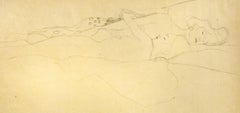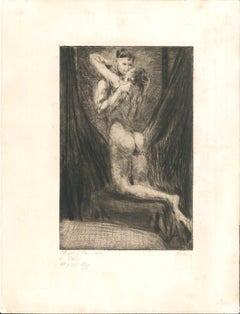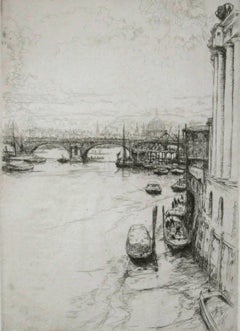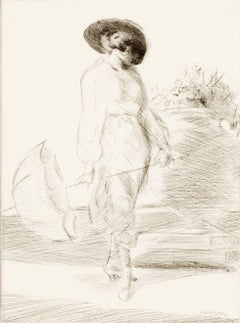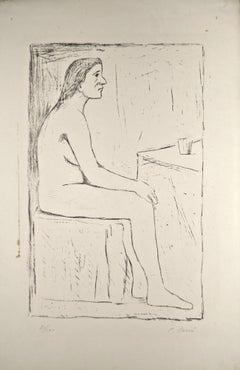1910s Art
13
to
46
353
97
52
251
228
204
4
281
63
59
24
18
Overall Height
to
Overall Width
to
450
299
138
132
41
14
11
5
2
2
329
151
135
131
90
77
73
36
34
27
24
24
20
19
18
16
16
15
15
15
1,203
5,250
36,590
6,691
192
450
1,046
2,263
2,012
6,440
5,886
4,508
2,214
1,000
1,101
60
43
7
5
5
92
88
86
70
55
Style: Modern
Period: 1910s
Woman and Young Lady - 1910s
Located in Roma, IT
Two Lying Female Nudes (Woman and Young Lady) is a vintage, beautiful, and rare collotype from “Gustav Klimt: Fünfundzwanzig Handzeichnungen”, a limited-edition collection of 25 monochrome and two-color collotypes after drawings by Gustav Klimt.
Published by Gilhofer and Ranschburg, Vienna, July 1919, just one year after Klimt...
Category
Modern 1910s Art
Materials
Black and White
Mein Weg mit dem Weib, plate 16
Located in Roma, IT
Drypoint and aquatint (brown ink) on cream paper.
Signed "Rehn" in pencil on the lower right margin. Titled and numbered in pencil on the lower left margin. Edition of 25 prints. Fro...
Category
Modern 1910s Art
Materials
Drypoint, Aquatint
Lion Brewery
By James McBey
Located in Storrs, CT
Lion Brewery. 1914. Etching. Hardie 149. 11 1/2 x 8 1/8 (sheet 13 5/8 x 10 1/8). Edition 50, #7. Illustrated: Salaman, Modern Masters of Etching. A fine impression of this scarce pri...
Category
Modern 1910s Art
Materials
Etching
In Versum Distulit Ulmos - Original Etching by Dunoyer de Segonzac - 1944/47
Located in Roma, IT
Hand signed. Edition of 200 copies.
This beautiful etching belongs to the series of illustrations that the French artist André Dunoyer de Segonzac realized for the "Georgics" by the...
Category
Modern 1910s Art
Materials
Drypoint, Etching
Summer
Located in Storrs, CT
Summer. 1914. Drypoint. Appleby 46. 6 7/8 x 4 7/8 (sheet 11 5/8 x 9 3/16). Edition 77. A fine impression printed on cream wove paper on the full sheet with deckle edges. Signed in pe...
Category
Modern 1910s Art
Materials
Drypoint
Seated Nude - Original Lithograph by Carlo Carrà - 1920 ca.
By Carlo Carrà
Located in Roma, IT
Edition of 100 prints. Hand signed and numbered.
Good conditions, just some minor stains on lower left margin.
This artwork is shipped from Italy. Under existing legislation, any a...
Category
Modern 1910s Art
Materials
Lithograph
"Circuit De L'Est" Original Aeronautical Lithograph Poster by Marguerite Montaut
Located in Milwaukee, WI
"Circuit De L'Est" is an original lithograph poster by Marguerite Montaut (GAMY). This artwork features an early biplane flying over farm fields. It is also passing over a river that...
Category
Modern 1910s Art
Materials
Lithograph, Ink
"The Model"
Located in Lambertville, NJ
Jim’s of Lambertville is proud to offer this artwork by:
Gershon Benjamin (1899-1985)
An American Modernist of portraits, landscapes, still lives, and the urban scene, Gershon Benj...
Category
Modern 1910s Art
Materials
Paper, Graphite
Tiber
Located in Roma, IT
Very rare xylograph of the artist, who was considered one of the 20th Century Masters in xylography. Title and signature printed on the lower margin. Very good condition. Passepartou...
Category
Modern 1910s Art
Materials
Woodcut
The Picador Incites the Bull.
By James McBey
Located in Storrs, CT
The Picador Incites the Bull. 1911. Drypoint. Hardie 104. 6 1/4 x 9 7/8 (sheet 8 1/4 x 11 7/8). Edition 30, #5. Slight mat line, 1 hinge stain in the lower margin, well outside the i...
Category
Modern 1910s Art
Materials
Drypoint
Mein Weg mit dem Weib, plate 7
Located in Roma, IT
Drypoint and aquatint (brown ink) on cream paper.
Signed in pencil on the lower right margin. Titled and numbered in pencil on the lower left margin. Edition of 25 prints. From the s...
Category
Modern 1910s Art
Materials
Drypoint, Aquatint
Le Blessé dans la Tranchée (variante 1) - Original Etching and Drypoint
Located in Roma, IT
Hand signed. Edition of 75 prints.Original Prints.
From the suite: “Huit Illustrations de Guerre”.
Image Dimensions : 16.5 x 11 cm
This artwork is shipped from Italy. Under existing...
Category
Modern 1910s Art
Materials
Drypoint
La Cavallerizza
Located in Roma, IT
"La Cavallerizza" is an original xylograph realized by Arturo Martini in 1914. Title and signature printed on the lower margin. Very good condition.
Passepartout included : 55 x 44....
Category
Modern 1910s Art
Materials
Woodcut
Before the Storm
Located in Buffalo, NY
An original watercolor on paper by American modernist Charles E. Burchfield, created in 1916.
This work comes in an archival frame presentation and has been authenticated by the Bur...
Category
Modern 1910s Art
Materials
Paper, Watercolor
Portrait of Woman
Located in Roma, IT
This very rare xylograph is in excellent conditions. Title and signature printed on the lower margin. The artist used the name of his mother "Martini de la Valle".
Passepartout included : 55 x 45 cm
Image Dimensions : 30 x 24.5 cm
Arturo Martini (1889-1947) was an Italian sculptor. He studied ceramics in Faenza and sculpture in Treviso. His copious artistic production is characterized by immediate plasticity, halcyon inventiveness, and thorough mastery of all technical processes: stone, bronze, terracotta...
Category
Modern 1910s Art
Materials
Woodcut
Piazza d'Armi, Rome - Original Woodcut Print - 1913
Located in Roma, IT
Piazza d'Armi is a very rare xylograph realized by Arturo Martini, one of the 20th-century masters in this technique. Title and signature printed on the lower margin.
Passepartout included : 45 x 55 cm
Image Dimensions : 22.5 x 29 cm
Arturo Martini (1889-1947) was an Italian sculptor. He studied ceramics in Faenza and sculpture in Treviso. His copious artistic production is characterized by immediate plasticity, halcyon inventiveness, and thorough mastery of all technical processes: stone, bronze, terracotta...
Category
Modern 1910s Art
Materials
Woodcut
Untitled (Trees)
Located in Buffalo, NY
An original watercolor on paper by American modernist Charles E. Burchfield, created in 1916.
This work comes in an archival frame presentation and has been authenticated by the Bur...
Category
American Modern 1910s Art
Materials
Paper, Watercolor
Have you a reason for not enlisting? World War One British Recruitment Poster
Located in London, GB
To see our other original vintage propaganda posters, scroll down to "More from this Seller" and below it click on "See all from this seller" - or send us a message if you cannot find the poster you want.
Parliamentary Recruiting Committee
Which? Have you a Reason for not Enlisting - Or only an Excuse for not Enlisting. Now!
Original lithographic poster c. 1914
75 x 50cm
Published by the Parliamentary Recruiting Committee, London
Printed by the Abbey Press 32 & 34 Great Peter St Westminster SW
Before conscription was introduced at the beginning of 1916, recruitment into the British Army was all by way of volunteering. Lord Kitchener...
Category
Modern 1910s Art
Materials
Lithograph
Original 1914 Ski Poster Zug Berg-u-Strassenbahn, Austria: Walther Koch - Skiing
By Walter Koch
Located in London, GB
Walther Koch (1875-1915)
Zug Berg und Strassenbahn
Original lithographic poster (1914)
40x30"
Printed in Zurich by Anstalt Gebr Fretz
Category
Modern 1910s Art
Materials
Lithograph
Strong Girl
By Walt Kuhn
Located in New York, NY
Walt Kuhn (1877-1949), Strong Girl, drypoint, 1916 [signed in pencil by Kenneth Hays Miller and inscribed “Zinc sheet E printed by Howard Moore Park 1928”). In very good condition, printed on a cream wove paper, 7 1/2 x 5 1/4, the sheet 11 1/8 x 8 1/2 inches.
Provenance: ex Collection: The Metropolitan Museum of New York, with their stamp verso.
ex Coll: Jonathan Greenberg, New York City
A very good impression of this rare early Kuhn print.
This is listed as number 48 in the Kennedy Galleries Walt Kuhn Checklist, made for an exhibit of his prints in 1967; it is cited as a print where no more than 6 impressions are known to exist.
Kuhn was of course intimately familiar with circuses and carnivals...
Category
American Modern 1910s Art
Materials
Drypoint
Advice
By Walt Kuhn
Located in New York, NY
Walt Kuhn (1877-1949), Advice, etching and drypoint, 1915, signed in pencil lower right and titled lower left. In generally good condition but obviously a proof impression, with marg...
Category
American Modern 1910s Art
Materials
Drypoint, Etching
Ojai, California
By Carl Lindin
Located in Saratoga Springs, NY
Signed lower left.
Category
Modern 1910s Art
Materials
Canvas, Oil
Ericsson's Day, No. 1.
Located in Storrs, CT
Ericsson's Day, No. 1. 1914. Etching. 6 x 9 (sheet 7 3/8 x 11). Printed on cream wove paper on the full sheet with deckle edges. Proof with subtle plate tone in sepia ink, printed by...
Category
American Modern 1910s Art
Materials
Etching, Pencil, Graphite
Large Antique American School Nocturnal Cityscape Nicely Framed Oil Painting
Located in Buffalo, NY
Antique American modernist nocturnal cityscape oil painting. Oil on canvas. Framed. Signed.
Category
Modern 1910s Art
Materials
Oil, Canvas
Reunion in the garden
By Alfred Reth
Located in Genève, GE
Work on watercolor paper
Golden wooden frame with glass pane
50.5 x 55.5 x 2.5 cm
Category
Modern 1910s Art
Materials
Watercolor
The Nude With Landscape - Etching and Drypoint by Pierre Girieud -1910s
Located in Roma, IT
Etching realized by Pierre Girieud (1876-1940).
Good condition with foxing, on a yellowed paper included a white cardboard passpartout (50 x 70 cm).
Hand signed on the lower right corner.
Pierre Girieud was a French painter (Marseille 1875 - Nogent-sur-Marne 1948). Follower of P. Gauguin, friend of Cézanne and Van Gogh, he painted still lifes, landscapes of Provence, naked, in a massive, archaic style, with influences of Italian Renaissance painting.
Category
Modern 1910s Art
Materials
Etching, Drypoint
Torse de face
Located in New York, NY
Henri Matisse
Torse de face, 1913
lithograph on Japanese vellum, edition 31 of 50
19 11/16 x 13 in. (50 x 33 cm)
Ref: Duthuit 407; Cat. 31
signed in ink and numbered 31/50
Category
Modern 1910s Art
Materials
Lithograph
Dark Portrait by Otto Vautier - Charcoal 48x35 cm
Located in Geneva, CH
Work on paper without frame
Category
Modern 1910s Art
Materials
Charcoal
Photographic Portrait and Signature of Wilhelm of Sweden - 1910s
Located in Roma, IT
Photographic portrait with autograph signature and date 1912 of Wilhelm of Sweden, Prince of Sweden and Norway, and son of Gustav V.
Marked by the photographer “Atelier Jaeger/Stock...
Category
Modern 1910s Art
Materials
Photographic Paper
The New Year's Cake - Woodcut after Kitagawa Utamaro - 1910 ca.
By Kitagawa Utamaro 1
Located in Roma, IT
The New Year's Cake is an original modern artwork realized after Kitagawa Utamaro (1753 –1806) and printed around 1910.
Original Bijinga reprint (double page book).
From the famou...
Category
Modern 1910s Art
Materials
Woodcut
Nature morte à l’oeuf - Roger de la Fresnaye, still life, modern, french, fruit
Located in London, GB
Roger de la Fresnaye (1885-1925)
Nature morte à l’oeuf
1910
oil on board mounted on panel
66.2 x 50.9 cm
signed and dated ‘R de la Fresnaye.10’ (upper right)
Price:
$157,500 USD (in...
Category
Modern 1910s Art
Materials
Oil, Panel, Board
The Workers - 20th Century, Lithograph by Christopher Nevinson
Located in London, GB
Edition of 50
Signed and dated lower right
Category
Modern 1910s Art
Materials
Lithograph
Banking at 4000 Feet - 20th Century, Lithograph by Christopher Nevinson
Located in London, GB
Edition of 200
Signed, dated and numbered
Category
Modern 1910s Art
Materials
Lithograph
Returning to the Trenches - 20th Century, Drypoint by Christopher Nevinson
Located in London, GB
Drypoint on off-white laid paper
Edition of 75
Signed & dated in pencil
Category
Modern 1910s Art
Materials
Drypoint
Troops Near Peronne - 20th Century, Pencil in paper by Christopher Nevinson
Located in London, GB
Signed and dated lower left
Titled lower right
Provenance: Gifted by the Artist to Martin Doyle
Gifted to Mrs Darlington
Thence by descent
Category
Modern 1910s Art
Materials
Pencil
German Double Pill-Box - 20th Century, Lithograph by Paul Nash
Located in London, GB
Signed & dated lower right. Dedicated in pencil to 'Sir Michael Sadler' upper left.
From the edition of 25
Category
Modern 1910s Art
Materials
Lithograph
Boxers by August Sander
Located in Morton Grove, IL
Boxers
August Sander (1876 – 1964)
1929/1991
photograph, gelatin silver print
Gelatin silver print, printed l991
Edition #2 of 12
10 1/4 x 6 5/8
Signed ...
Category
Modern 1910s Art
Materials
Silver Gelatin
Grandmother and Nude Louise - Original handsigned etching
Located in Paris, FR
Suzanne VALADON
Grandmother and Nude Louise
Original engraving (drypoint)
Handsigned in pencil (and also printed signiture in the plate)
On BFK Rives vellum 47 x 37 cm (c. 18.5 x 14...
Category
Modern 1910s Art
Materials
Etching
Three Girls
Located in Missouri, MO
Gisella Loeffler
"Three Girlsl" c. 1919
Gouache on Paper
Initialed Lower Left
Framed Size: approx 19 x 13 inches
In a village filled with colorful characters, few Taos artists were as colorful as Gisella Loeffler [1900-1977]. From her handmade Austrian clothing and hand-painted furniture to whimsical paintings and letters written in multicolored crayon, joyful color defined the artist, who early on chose to use simply Gisella as her professional name and was known as such to everyone in Taos.
In spite of her fame there—the Taos News once labeled her a Taos legend—Gisella is rarely included in scholarly discussions of the Taos Art Colony. This oversight is likely due to the naive quality of her work, in which children or childlike adults inhabit a simple, brightly colored world filled with happiness. The macabre, the sad, the tortured, the offensive—all have no place in Gisella’s paintings. Her naive style of work looks very different from that of the better-known early Taos artists. Yet both Gisella’s artwork and her interesting life command attention.
Born in Austria, Gisella came to the United States with her family in 1908, settling in St. Louis, MO. After studying art at Washington University in St. Louis, she became a prominent member of the local art community, joining the St. Louis Art Guild as well as the Boston Society of Arts and Crafts. In addition to creating posters for the St. Louis Post Dispatch, Gisella won prizes from the Artists Guild of the Author’s League of America in 1919 and 1920 and from the Kansas City Art Institute in 1923. She also began working in textiles, including batik, to which she would return later in her career.
In the early 1920s Gisella married writer and music critic Edgar Lacher. A difficult character, Lacher may have chafed under Gisella’s success, for the couple divorced in the 1930s.
Having seen a local exhibition of paintings by Taos artists Oscar Berninghaus (who was from St. Louis) and Ernest Blumenschein, Gisella felt drawn to Taos, which reminded her of the villages of her native Austria. In 1933 the single mother with two daughters, Undine and Aithra, moved to Taos, where she lived off and on for the rest of her life. She traveled frequently, spending extended periods in Mexico, South America, and California, but always returned to New Mexico.
Gisella initially applied an Austro-Hungarian folk-art style to the Indian and Hispanic subjects that she found in New Mexico. In her early work she covered her surfaces with decorative floral and faunal motifs, and her images were flat with no attempt at rendering traditional one-point perspective. Eventually, though, Gisella developed her own style, often using children or childlike figures as subjects. Still, the influence of her native country’s folk art remained evident in her New Mexican, Mexican, and South American images.
In 1938 Gisella moved briefly to Los Griegos, north of Albuquerque, to be closer to medical facilities for her eldest daughter, who was suffering from rheumatic fever. Two years later, she moved to California to participate in the war effort, painting camouflage and decals on airplanes for Lockheed.
In California, Gisella broadened her range of artistic pursuits. She taught art privately, created illustrations for Scripts Magazine, and did interior design for private homes. She also designed greeting cards, a practice she continued after her return to New Mexico, where she created a series of Christmas cards.
Gisella began illustrating children’s books in 1941 when she collaborated on Franzi and Gizi with author Margery Bianco. Eventually she wrote and illustrated her own book, El Ekeko, in 1964. She also designed ceramics—her Happy Time Dinnerware, marketed by Poppy Trail...
Category
Modern 1910s Art
Materials
Gouache
Mother and Child In the Garden
Located in Missouri, MO
Gisella Loeffler
"Mother and Child in the Gardenl" 1919
Gouache on Paper
Initialed Lower Right
Framed Size: approx 19 x 10 3/4 inches
In a village filled with colorful characters, few Taos artists were as colorful as Gisella Loeffler [1900-1977]. From her handmade Austrian clothing and hand-painted furniture to whimsical paintings and letters written in multicolored crayon, joyful color defined the artist, who early on chose to use simply Gisella as her professional name and was known as such to everyone in Taos.
In spite of her fame there—the Taos News once labeled her a Taos legend—Gisella is rarely included in scholarly discussions of the Taos Art Colony. This oversight is likely due to the naive quality of her work, in which children or childlike adults inhabit a simple, brightly colored world filled with happiness. The macabre, the sad, the tortured, the offensive—all have no place in Gisella’s paintings. Her naive style of work looks very different from that of the better-known early Taos artists. Yet both Gisella’s artwork and her interesting life command attention.
Born in Austria, Gisella came to the United States with her family in 1908, settling in St. Louis, MO. After studying art at Washington University in St. Louis, she became a prominent member of the local art community, joining the St. Louis Art Guild as well as the Boston Society of Arts and Crafts. In addition to creating posters for the St. Louis Post Dispatch, Gisella won prizes from the Artists Guild of the Author’s League of America in 1919 and 1920 and from the Kansas City Art Institute in 1923. She also began working in textiles, including batik, to which she would return later in her career.
In the early 1920s Gisella married writer and music critic Edgar Lacher. A difficult character, Lacher may have chafed under Gisella’s success, for the couple divorced in the 1930s.
Having seen a local exhibition of paintings by Taos artists Oscar Berninghaus (who was from St. Louis) and Ernest Blumenschein, Gisella felt drawn to Taos, which reminded her of the villages of her native Austria. In 1933 the single mother with two daughters, Undine and Aithra, moved to Taos, where she lived off and on for the rest of her life. She traveled frequently, spending extended periods in Mexico, South America, and California, but always returned to New Mexico.
Gisella initially applied an Austro-Hungarian folk-art style to the Indian and Hispanic subjects that she found in New Mexico. In her early work she covered her surfaces with decorative floral and faunal motifs, and her images were flat with no attempt at rendering traditional one-point perspective. Eventually, though, Gisella developed her own style, often using children or childlike figures as subjects. Still, the influence of her native country’s folk art remained evident in her New Mexican, Mexican, and South American images.
In 1938 Gisella moved briefly to Los Griegos, north of Albuquerque, to be closer to medical facilities for her eldest daughter, who was suffering from rheumatic fever. Two years later, she moved to California to participate in the war effort, painting camouflage and decals on airplanes for Lockheed.
In California, Gisella broadened her range of artistic pursuits. She taught art privately, created illustrations for Scripts Magazine, and did interior design for private homes. She also designed greeting cards, a practice she continued after her return to New Mexico, where she created a series of Christmas cards.
Gisella began illustrating children’s books in 1941 when she collaborated on Franzi and Gizi with author Margery Bianco. Eventually she wrote and illustrated her own book, El Ekeko, in 1964. She also designed ceramics—her Happy Time Dinnerware, marketed by Poppy Trail...
Category
Modern 1910s Art
Materials
Gouache
The Necklace and the Pot
Located in Missouri, MO
Gisella Loeffler
"The Necklace and the Pot" c. 1919
Gouache on Paper
Initialed Lower Left
Framed Size: approx 15 x 15 inches
In a village filled with colorful characters, few Taos artists were as colorful as Gisella Loeffler [1900-1977]. From her handmade Austrian clothing and hand-painted furniture to whimsical paintings and letters written in multicolored crayon, joyful color defined the artist, who early on chose to use simply Gisella as her professional name and was known as such to everyone in Taos.
In spite of her fame there—the Taos News once labeled her a Taos legend—Gisella is rarely included in scholarly discussions of the Taos Art Colony. This oversight is likely due to the naive quality of her work, in which children or childlike adults inhabit a simple, brightly colored world filled with happiness. The macabre, the sad, the tortured, the offensive—all have no place in Gisella’s paintings. Her naive style of work looks very different from that of the better-known early Taos artists. Yet both Gisella’s artwork and her interesting life command attention.
Born in Austria, Gisella came to the United States with her family in 1908, settling in St. Louis, MO. After studying art at Washington University in St. Louis, she became a prominent member of the local art community, joining the St. Louis Art Guild as well as the Boston Society of Arts and Crafts. In addition to creating posters for the St. Louis Post Dispatch, Gisella won prizes from the Artists Guild of the Author’s League of America in 1919 and 1920 and from the Kansas City Art Institute in 1923. She also began working in textiles, including batik, to which she would return later in her career.
In the early 1920s Gisella married writer and music critic Edgar Lacher. A difficult character, Lacher may have chafed under Gisella’s success, for the couple divorced in the 1930s.
Having seen a local exhibition of paintings by Taos artists Oscar Berninghaus (who was from St. Louis) and Ernest Blumenschein, Gisella felt drawn to Taos, which reminded her of the villages of her native Austria. In 1933 the single mother with two daughters, Undine and Aithra, moved to Taos, where she lived off and on for the rest of her life. She traveled frequently, spending extended periods in Mexico, South America, and California, but always returned to New Mexico.
Gisella initially applied an Austro-Hungarian folk-art style to the Indian and Hispanic subjects that she found in New Mexico. In her early work she covered her surfaces with decorative floral and faunal motifs, and her images were flat with no attempt at rendering traditional one-point perspective. Eventually, though, Gisella developed her own style, often using children or childlike figures as subjects. Still, the influence of her native country’s folk art remained evident in her New Mexican, Mexican, and South American images.
In 1938 Gisella moved briefly to Los Griegos, north of Albuquerque, to be closer to medical facilities for her eldest daughter, who was suffering from rheumatic fever. Two years later, she moved to California to participate in the war effort, painting camouflage and decals on airplanes for Lockheed.
In California, Gisella broadened her range of artistic pursuits. She taught art privately, created illustrations for Scripts Magazine, and did interior design for private homes. She also designed greeting cards, a practice she continued after her return to New Mexico, where she created a series of Christmas cards.
Gisella began illustrating children’s books in 1941 when she collaborated on Franzi and Gizi with author Margery Bianco. Eventually she wrote and illustrated her own book, El Ekeko, in 1964. She also designed ceramics—her Happy Time Dinnerware, marketed by Poppy Trail...
Category
Modern 1910s Art
Materials
Gouache
Going for a Stroll
Located in Missouri, MO
Gisella Loeffler
"Going for a Stroll" c. 1919
Gouache on Paper
Initialed
Framed Size: approx 17 x 13 inches
In a village filled with colorful characters, few Taos artists were as colorful as Gisella Loeffler [1900-1977]. From her handmade Austrian clothing and hand-painted furniture to whimsical paintings and letters written in multicolored crayon, joyful color defined the artist, who early on chose to use simply Gisella as her professional name and was known as such to everyone in Taos.
In spite of her fame there—the Taos News once labeled her a Taos legend—Gisella is rarely included in scholarly discussions of the Taos Art Colony. This oversight is likely due to the naive quality of her work, in which children or childlike adults inhabit a simple, brightly colored world filled with happiness. The macabre, the sad, the tortured, the offensive—all have no place in Gisella’s paintings. Her naive style of work looks very different from that of the better-known early Taos artists. Yet both Gisella’s artwork and her interesting life command attention.
Born in Austria, Gisella came to the United States with her family in 1908, settling in St. Louis, MO. After studying art at Washington University in St. Louis, she became a prominent member of the local art community, joining the St. Louis Art Guild as well as the Boston Society of Arts and Crafts. In addition to creating posters for the St. Louis Post Dispatch, Gisella won prizes from the Artists Guild of the Author’s League of America in 1919 and 1920 and from the Kansas City Art Institute in 1923. She also began working in textiles, including batik, to which she would return later in her career.
In the early 1920s Gisella married writer and music critic Edgar Lacher. A difficult character, Lacher may have chafed under Gisella’s success, for the couple divorced in the 1930s.
Having seen a local exhibition of paintings by Taos artists Oscar Berninghaus (who was from St. Louis) and Ernest Blumenschein, Gisella felt drawn to Taos, which reminded her of the villages of her native Austria. In 1933 the single mother with two daughters, Undine and Aithra, moved to Taos, where she lived off and on for the rest of her life. She traveled frequently, spending extended periods in Mexico, South America, and California, but always returned to New Mexico.
Gisella initially applied an Austro-Hungarian folk-art style to the Indian and Hispanic subjects that she found in New Mexico. In her early work she covered her surfaces with decorative floral and faunal motifs, and her images were flat with no attempt at rendering traditional one-point perspective. Eventually, though, Gisella developed her own style, often using children or childlike figures as subjects. Still, the influence of her native country’s folk art remained evident in her New Mexican, Mexican, and South American images.
In 1938 Gisella moved briefly to Los Griegos, north of Albuquerque, to be closer to medical facilities for her eldest daughter, who was suffering from rheumatic fever. Two years later, she moved to California to participate in the war effort, painting camouflage and decals on airplanes for Lockheed.
In California, Gisella broadened her range of artistic pursuits. She taught art privately, created illustrations for Scripts Magazine, and did interior design for private homes. She also designed greeting cards, a practice she continued after her return to New Mexico, where she created a series of Christmas cards.
Gisella began illustrating children’s books in 1941 when she collaborated on Franzi and Gizi with author Margery Bianco. Eventually she wrote and illustrated her own book, El Ekeko, in 1964. She also designed ceramics—her Happy Time Dinnerware, marketed by Poppy Trail...
Category
Modern 1910s Art
Materials
Gouache
Driving Home in the Rain
Located in Storrs, CT
Driving Home in the Rain. 1914. Drypoint. Appleby 35. 7 3/8 x 10 1/8 (sheet 12 x 15 3/8). Edition 40. Illustrated: Guichard, British Etchers, 1850-1940; Print Collector's Quarterly 1...
Category
Modern 1910s Art
Materials
Drypoint
The Temples of New York
Located in London, GB
Signed lower right
Category
Modern 1910s Art
Materials
Drypoint
